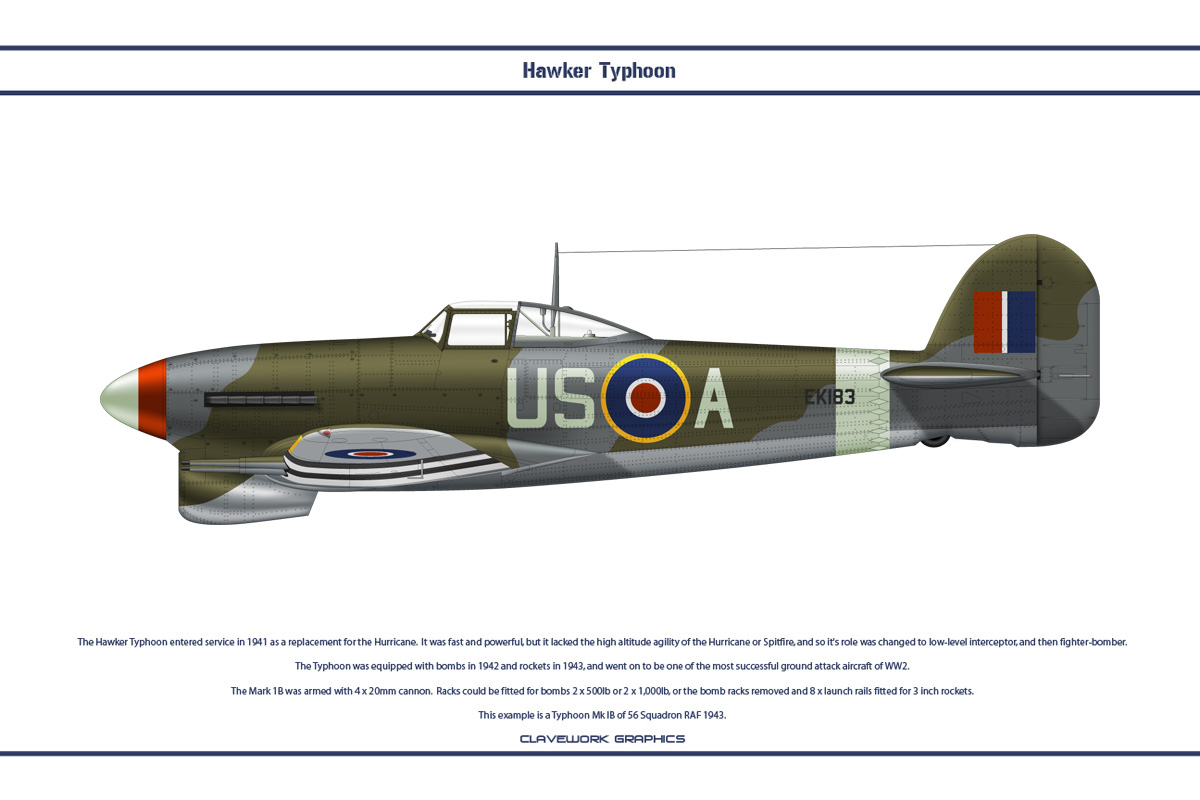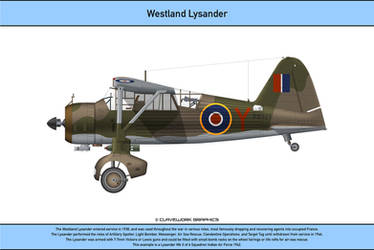ShopDreamUp AI ArtDreamUp
Deviation Actions
Description
The Hawker Typhoon entered service in 1941 as a replacement for the Hurricane. It was fast and powerful, with over 2,000hp from it's Napier engine, but it lacked the high altitude agility of the Hurricane or Spitfire, and so it's role was changed to low-level interceptor, and then fighter-bomber.
The Typhoon was equipped with bombs in 1942 and rockets in 1943, and went on to be one of the most successful ground attack aircraft of WW2.
The Mark 1B was armed with 4 x 20mm cannon. Racks could be fitted for bombs 2 x 500lb or 2 x 1,000lb, or the bomb racks removed and 8 x launch rails fitted for 3 inch rockets.
This example is a Typhoon Mk IB of 56 Squadron RAF 1943.
The Typhoon was equipped with bombs in 1942 and rockets in 1943, and went on to be one of the most successful ground attack aircraft of WW2.
The Mark 1B was armed with 4 x 20mm cannon. Racks could be fitted for bombs 2 x 500lb or 2 x 1,000lb, or the bomb racks removed and 8 x launch rails fitted for 3 inch rockets.
This example is a Typhoon Mk IB of 56 Squadron RAF 1943.
Image size
1200x800px 165.15 KB
© 2010 - 2024 Claveworks
Comments5
Join the community to add your comment. Already a deviant? Log In
Typhoon Mk Ib US-A EK183 of 56 RAF Squadron, flown by S/L Thomas Henry Vicent "THV" Pheloung RAF (31 August 1914 - 20 June 1943) of Oamaru, New Zealand.
Enlisted in RAF on short service commission after serving in RNZAF in 1937.
THV took command of 56 RAF Squadron on 17 January 1943.
He was killed attacking a German convoy off the coast of the Netherlands,FLAK from the ships hit his aircraft (he was flying EK174 at the time) and in trying to return to England his wingman could only watch on helplessly as the aircraft flipped over and was then seen to plunge straight down into the sea,with no parachute sighted nor wreckage left floating in the water.
(another relation was killed with RAF Bomber Command)
56 RAF Squadron was the first unit to fly the Typhoon in May 1942.
The Typhoon was the replacement for the Hawker Hurricane, but troubles with development limited its performance.
Some examples of these are -
the tailplane had to be strengthened after a number of accidents involving loss of the tailplane during high speed dives
The engine also was prone to catching fire
EK183 had a "car door" canopy, where the pilot would enter through the side of the aircraft like in a car.
This was changed to a "bubbletop" canopy for better visibility and to aid in ease of escape in the event of aircrew needing to abandon their aircraft in the air by parachute, or after ditching as a standard fix on later models.
The alternating bands of white and black markings on the wings were ordered to be applied to the Typhoon in December 1942, because Allied pilots had trouble distinguishing between the Typhoon and the FW-190, with some sad cases of 'friendly fire' taking place before this was enforced.
The propeller spinner was also painted a light gray ("sky") as a further aid to identification.
The Hawker Tempest its later sister, eliminated many of the Typhoon's problems and was a successful fighter well into the 1950s.
Some very good and clear picks of his Typhoon can be seen here -
[link]
the RNZAF Official history records his loss this way -
"Raids on enemy ships in the Channel and the Straits of Dover were now becoming an important part of RAF Fighter Command's work and Squadron Leaders Pheloung and Kilian both led RAF squadrons engaged on such duties.
Pheloung's Typhoons were stationed in Norfolk and usually operated over Dutch coastal waters, while Kilian's Spitfires flew patrols over the Channel from an airfield in Hampshire.
Both squadrons reported many successful missions.
In these attacks on enemy shipping, the Typhoon fighter-bombers were frequently supported by long-range Spitfires which took the anti-flak role, sweeping in ahead to silence the German gunners.
Such co-ordinated assaults proved extremely effective although determined enemy gunners often gave the first aircraft a hot reception.
While leading a June attack on a convoy off the Hook of Holland Pheloung lost his life.
His machine was hit by fire from the ships, and during the return flight it was suddenly seen to make a sharp diving turn and then go straight down into the sea".
Enlisted in RAF on short service commission after serving in RNZAF in 1937.
THV took command of 56 RAF Squadron on 17 January 1943.
He was killed attacking a German convoy off the coast of the Netherlands,FLAK from the ships hit his aircraft (he was flying EK174 at the time) and in trying to return to England his wingman could only watch on helplessly as the aircraft flipped over and was then seen to plunge straight down into the sea,with no parachute sighted nor wreckage left floating in the water.
(another relation was killed with RAF Bomber Command)
56 RAF Squadron was the first unit to fly the Typhoon in May 1942.
The Typhoon was the replacement for the Hawker Hurricane, but troubles with development limited its performance.
Some examples of these are -
the tailplane had to be strengthened after a number of accidents involving loss of the tailplane during high speed dives
The engine also was prone to catching fire
EK183 had a "car door" canopy, where the pilot would enter through the side of the aircraft like in a car.
This was changed to a "bubbletop" canopy for better visibility and to aid in ease of escape in the event of aircrew needing to abandon their aircraft in the air by parachute, or after ditching as a standard fix on later models.
The alternating bands of white and black markings on the wings were ordered to be applied to the Typhoon in December 1942, because Allied pilots had trouble distinguishing between the Typhoon and the FW-190, with some sad cases of 'friendly fire' taking place before this was enforced.
The propeller spinner was also painted a light gray ("sky") as a further aid to identification.
The Hawker Tempest its later sister, eliminated many of the Typhoon's problems and was a successful fighter well into the 1950s.
Some very good and clear picks of his Typhoon can be seen here -
[link]
the RNZAF Official history records his loss this way -
"Raids on enemy ships in the Channel and the Straits of Dover were now becoming an important part of RAF Fighter Command's work and Squadron Leaders Pheloung and Kilian both led RAF squadrons engaged on such duties.
Pheloung's Typhoons were stationed in Norfolk and usually operated over Dutch coastal waters, while Kilian's Spitfires flew patrols over the Channel from an airfield in Hampshire.
Both squadrons reported many successful missions.
In these attacks on enemy shipping, the Typhoon fighter-bombers were frequently supported by long-range Spitfires which took the anti-flak role, sweeping in ahead to silence the German gunners.
Such co-ordinated assaults proved extremely effective although determined enemy gunners often gave the first aircraft a hot reception.
While leading a June attack on a convoy off the Hook of Holland Pheloung lost his life.
His machine was hit by fire from the ships, and during the return flight it was suddenly seen to make a sharp diving turn and then go straight down into the sea".































